Goesan Historic House of Song Byeong-il (괴산 송병일 고택)
0m 15837 2024-02-15
17 Cheongcheon 4-gil, Cheongcheon-myeon, Goesan-gun, Chungcheongbuk-do
This dwelling is a well-preserved example of a traditional Korean house built in the late 19th century, a relic from the era of the Joseon dynasty. It offers insight into the architectural design of the period as well as the domestic life of the Joseon aristocracy. The house also bears historical significance as the residence of the descendants of Uam Song Siyeol, a prominent Neo-Confucian scholar of the dynasty. The layout features distinct sarangchae (the men's quarter) and anchae (the women's quarter), with a gate and a storage facility for essential supplies situated between them. This set up offers visitors an authentic experience of the Joseon dynasty’s traditional household structures. Encircled by a tranquil forest, this old house transports visitors to a time long past..
Hwayang Valley (Hwayangdonggyegok Valley) (화양구곡 (화양동계곡))
5.8 Km 9826 2019-11-06
78, Hwayangdong-gil, Cheongcheon-myeon, Goesan-gun, Chungcheongbuk-do
+82-43-832-4347
Hwayang Valley, located 32 kilometers east from Cheongju, was designated Songnisan National Park in 1975.
The vivid green mountains and clear waters make it a highly sought after tourist spot. The nearby Seonnyudonggyegok Valley, just 7 kilometers away, is also a huge draw for travelers.
Hwayang Valley is composed of various shaped rocks such as Cheomseongdae Observatory, Neungundae Observatory, Waryongam Rock and Eupgungam Rock. Well-known statesman from the Joseon Dynasty, Song Si-yeol, visited the valley and wept for King Hyojong offering his final bow. This rock where he cried was then named Eupgungam Rock meaning ‘crying bow’ Rock. Waryongam Rock gets its name from its shape, which is said to look like a wriggly dragon. Cheomseongdae Observatory was used in order to forecast weather patterns.
Midongsan Arboretum (미동산수목원)
7.3 Km 44652 2014-10-13
51, Sumogwon-gil, Miwon-myeon, Sangdang-gu, Cheongju-si, Chungcheongbuk-do
+82-43-220-6101
Opened on May 4, 2001, Midongsan Arboretum in Cheongju, Chungcheongbuk-do is a provincial arboretum, built to develop and propagate forestry techniques and found ecological education environments.
Covering an area of 3,114,049.60㎡ (942,000 pyeong), the arboretum houses almost 873 species of plants and 652,000 plants in 11 exhibition halls including an Oak tree hall, a Maple tree hall, and a genetics hall, which presents plant genetic resources like Jeongipumsong hugyemok (succession of pine tree).
In addition to the 11 themed arboretum halls, Midongsan Arboretum also has a forestry educational hall, plant seed bank, research center for wild plants, nature experience camp, and more.
Jwagusan Recreational Forest (좌구산 자연휴양림)
9.1 Km 18682 2021-06-04
107, Sotjeommal-gil, Jeungpyeong-gun, Chungcheongbuk-do
82-43-835-4551
Jwagusan Recreational Forest is located at the foot of Jwagusan Mountain (alt. 657 meters). The name of the mountain means a sitting turtle because of the shape of the mountain. The lush forest along the hiking trail offers a refreshing stroll through the woods and the nearby Samgi Reservoir adds to the picturesque beauty of the mountain on misty days. The forest offers easy access to many recreational facilities in the area including a resort village, Samgi Reservoir, a woodland park, and a mountain bike course.
Mungwang Reservoir (문광저수지)
11.8 Km 0 2024-02-15
16 Yanggok-ri, Mungwang-myeon, Goesan-gun, Chungcheongbuk-do
Encircled by a 2-kilometer stretch of roads lined with ginkgo trees, this reservoir lies at the heart of Yanggok-ri, a quintessential small farming village. Its primary role is agricultural water supply, yet it doubles as a serene haven for both locals and tourists to stroll and reflect. Established in May 1978, this semi-valley reservoir boasts a rich, dense woodland and an array of ancient trees, contributing to its picturesque allure. The entrance is graced with an avenue of trees, which, come autumn, transforms into a golden canopy as the ginkgo leaves change hue. It’s a popular locale for families to convene, enjoying leisurely fishing and the peaceful surroundings.
Nangchugol Learning Park (낭추골 현장체험학습원)
12.8 Km 22542 2024-02-23
1890 Danjae-ro, Nangseong-myeon, Sangdang-gu, Cheongju-si, Chungcheongbuk-do
Nangchugol is a mountain village located in the eastern part of Cheongju, offering children the chance to observe and experience nature through play and a variety of activities. It boasts a goblin trail, four-season sledding options (grass sled, water sled, and snow sled), swimming pools, a nature learning center focusing on wild plants, valleys, and animals, a traditional game ground, an adventure playground, an insect experience center, and guided forest tours. Additionally, the village includes a campground for visitors.
Seonyudonggyegok Valley (선유구곡(선유동계곡))
12.9 Km 7583 2021-07-29
179, Seonyudong-gil, Goesan-gun, Chungcheongbuk-do
+82-43-832-4347
Seonyudonggyegok Valley is located in Goesan-gun, Chungcheongbuk-do Province. Including Seonyudongmun, the playground for the mountain gods, a total of nine valleys form the area: Gyeongcheonbyeok, Haksoam, Yeondallo, Waryongpok, Nangadae, Gigugam, Guam, and Eunseonam.
Seonnyudonggyegok Valley is famous for the legend that mountain gods came to savor fresh mountain spring water. A renowned geographical account, Taekriji, published in 1751, stated that Seonyudonggyegok Valley boasted some of the best scenery. One of the most eminent Confucian scholars of the Joseon dynasty, Lee Hwang spent nine months in this beautiful valley. He gave names to all his favorite places, which still remain to this day.
Songnisan National Park (Gyeongbuk Section) (속리산국립공원(경북))
13.0 Km 17158 2021-05-14
Hwabuk-myeon, Sangju-si, Gyeongsangbuk-do
+82-43-542-5267
On Songnisan Mountain is a rock summit 1,054 meters above sea level called Munjangdae Peak. The peak is so broad that 50 adults can sit on it at the same time. Among the rocks there is Seokcheon Pond, which never dries up. The peak used to be called “Unjangdae” because the summit is always covered with clouds and mist. Legend says that King Sejo of Joseon dynasty supposedly recited a poem on the summit.
Munjangdae has a great view of Cheonhwangbong Peak, the highest peak of Songnisan Mountain. Visitors can also see Gwaneumbong, Chilseongbong, Sirubong, Tugubong, Munsubong, and Birobong peaks. In autumn, visitors can enjoy views of breathtaking fall foliage along the trail, which begins at Hwabuk-myeon, Sangju. There are also many cultural heritage sites including Janggakpokpo Falls, Seongbuksa Temple, Osongpokpo Falls and Gyeonhwonsanseong Fortress.
Gallongyegok Valley (갈론계곡)
13.0 Km 39890 2024-02-26
547, Chilseong-ro 10-gil, Chilseong-myeon, Goesan-gun, Chungcheongbuk-do
속리산국립공원 북부에 있는 깊은 계곡이다. 신선이 내려왔다는 전설과 7마리의 학이 산다는 전설의 바위가 있고, 숲이 우거져 있다. 유리알같이 맑은 계곡이 곳곳에 비경을 만들고 있으며 물놀이하기에도 좋은 곳이다. 입구에 있는 산촌체험관에서는 숙박이 가능하다.
Goesanho Lake (괴산호)
13.8 Km 15992 2019-11-13
Chilseong-myeon, Goesan-gun, Chungcheongbuk-do
+82-43-830-3114
Goesanho Lake is located in the Chilseong-myeon area of Goesan-gun. The lake is abundant in a variety of freshwater fish, which makes it a famous year-round fishing site.
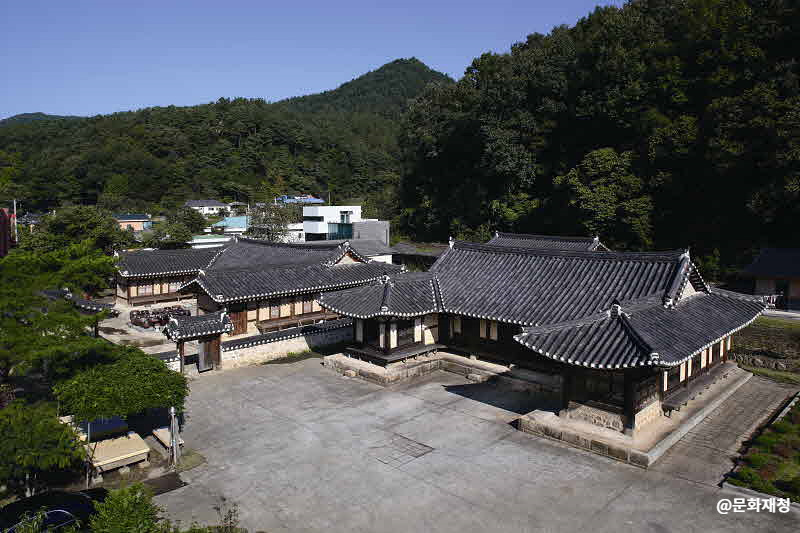

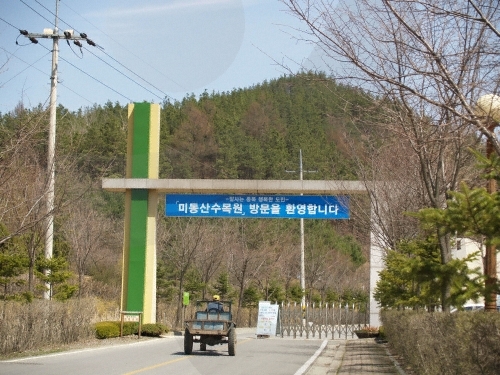
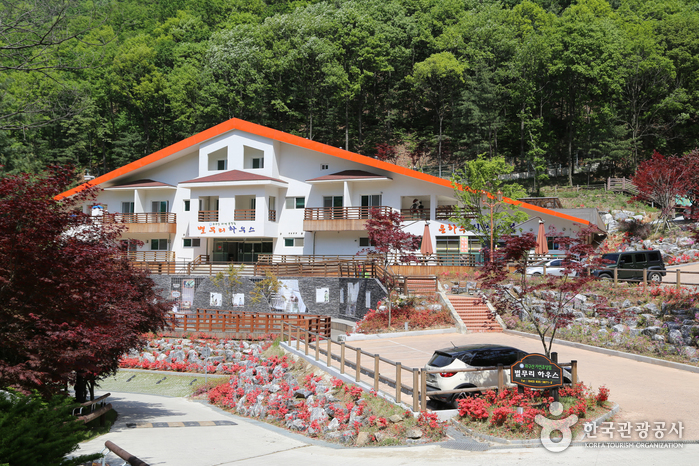
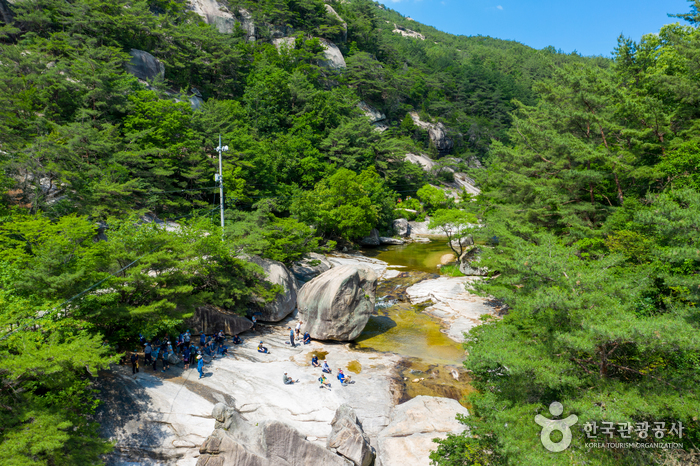
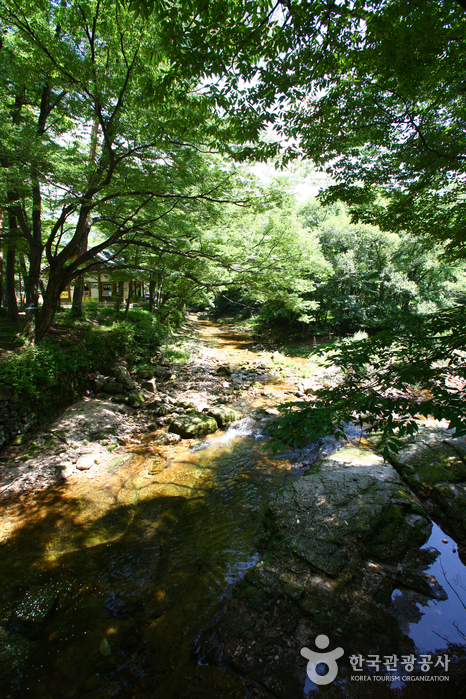
 English
English
 한국어
한국어 日本語
日本語 中文(简体)
中文(简体) Deutsch
Deutsch Français
Français Español
Español Русский
Русский